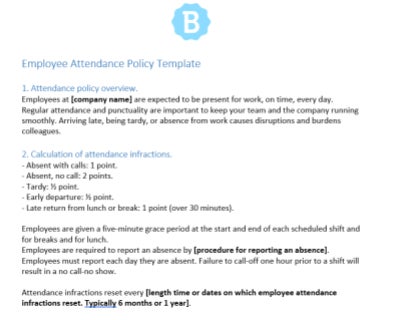
Attendance Policy Template Download
Download this attendance policy template in Word, and quickly customize it to work for your business. Instant download, no email required.
Download NowEmployee Attendance Policy Template:
1. Overview.
Employees at [company name] are expected to be present for work, on time, every day. Regular attendance and punctuality are important to keep your team and [company name] operating. Arriving late, being tardy, or absence causes disruptions.
2. Calculation of attendance infractions.
- Absent with calls: 1 point.
- Absent, no call: 2 points.
- Tardy: ½ point.
- Early departure: ½ point.
- Late return from lunch or break: 1 point (over 30 minutes).
Employees are given a five-minute grace period at the start and end of each scheduled shift and for breaks and for lunch. Employees are required to report an absence by [procedure for reporting an absence]. Employees must report each day they are absent. Failure to call-off one hour prior to a shift will result in a no call-no show.
Attendance infractions reset every [length time or dates on which employee attendance infractions reset. Typically 6 months or 1 year].
3. Overview of disciplinary action for attendance infractions.
Attendance issues will result in progressive disciplinary action up to and including termination based on the following point system:
- 3 points: Verbal warning.
- 4 points: Written warning.
- 5 points: Meeting with manager/supervisor, possible suspension.
- 6 points: Employee is subject to termination.
If an employee is absent for three or more consecutive days, evidence for excusing the absence, such as a doctor’s note, must be provided.
If an employee is a no call-no show for three or more consecutive days it will be considered a job abandonment, or termination without notice.
Employees may request exceptions for work absences from human resources and management. These must be approved on a case-by-case basis.
4. Excused, unpaid absences without disciplinary action.
Excused, unpaid absences can be granted for funerals, jury duty, bereavement, childbirth, a car accident, medical appointment, and unavoidable emergencies. In these cases, employees must provide documentation to prove a reason for the absence.
5. Failure to clock-In or clock-out.
Employees must clock-in and clock-out for each shift. If there is any problem recording a clock-in or clock-out, employees should inform a manager immediately. Employees who consistently fail to clock-in or clock-out may receive disciplinary action, up to and including termination.
6. Attendance policy exceptions.
Absence because of bereavement, jury duty, or military duty, are exempt from disciplinary action, as are FMLA and ADA-related absences. Bereavement, jury duty, and military exemptions require proper documentation to be given to a manager within 48 hours of the absence.


